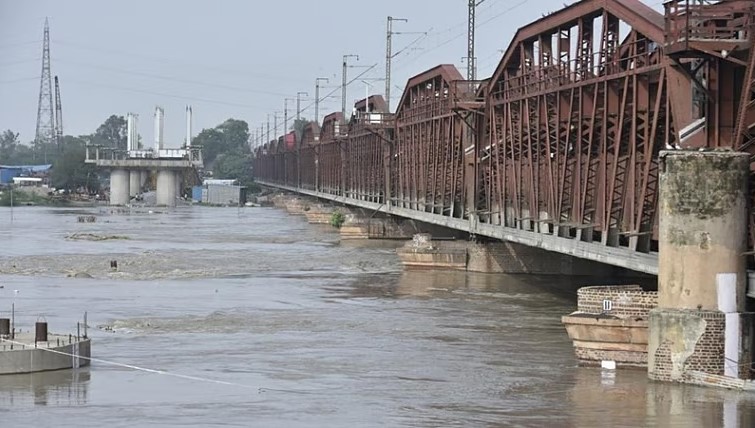The Centre has seen a change of guard of several prime ministers and chief ministers, both in Delhi and UP. None of them was able to clean up our rivers

The Lt Governor, VK Saxena, caustically informed the outgoing Delhi chief minister Atishi, when she went to the Raj Bhawan to submit her resignation, that her party had lost the Assembly elections because she was “cursed by Yamuna Maiya.”
Not only are the waters of the Yamuna toxic, thanks to the huge quantities of untreated sewage, industrial waste, and agricultural runoff being dumped in its waters, but it is shocking to hear a constitutional head of a Union Territory greet a losing chief minister with such toxic language.
We all know a slew of factors led to AAP’s overwhelming defeat. The sharp deterioration of the capital’s environment was a contributory factor. Delhiites, by and large, are extremely upset with high levels of air pollution and the increased water quality deterioration of the Yamuna river. The lack of attention to both these issues proved a major minus for the Kejriwal government.
As a Delhiite, I would like to ask the Lt Governor just how many press meets has the Minister of Environment, Bhupendra Yadav, held on both these crucial issues. Yadav is known to have spent most of his time working behind the scenes to boost the BJP’s electoral prospects for the Lok Sabha and state elections during the last two years.
The fact is that air pollution levels have risen drastically, and during the winter months, levels of air pollution from Delhi right down to Patna are so high that entire cities are engulfed in a thick smog. India also has some of the most polluted rivers in the world, and this should be a matter of shame for all of us.
In 2024, Yadav was informed by none other than the Central Pollution Control Board that 80 per cent of India’s rivers are highly polluted. The five top polluted rivers of the north are the Ganga, Yamuna, Godavari, Ghaggar and Gomti. Despite Rs 40,000 crore having been spent on cleaning the Ganga, the CPCB has found that the Ganga basin generates about 12,000 MLD of sewage for which the treatment capacity is only 4,000 MLD.
The situation with the Ganga worsens every summer when over 50 lakh pilgrims visit the Char Dham shrines. A large number of hotels have come up in Gangotri and Yamunotri to cater to this tourism rush, all of whom are known to discharge their untreated sewage directly into the river. Untreated sewage continues to be poured into these rivers across their entire length.
From the 97 monitoring stations put across its length to monitor pollutants in the Ganga, water samples confirm alarming levels of faecal coliform. Yamuna’s journey follows the same trajectory. By the time the Yamuna enters Delhi, it is covered with a toxic foam that contains high levels of ammonia and phosphates.
One of Rajiv Gandhi’s cherished dreams was to clean up the Ganga, and, as far back as 1986, he launched the Ganga Action Plan to remove pollutants from the river and to improve its water quality. Hundreds of crores have been spent on this cleaning-up project to little avail. But when Rajiv Gandhi lost the prime ministerial elections in 1989, the then president of India, President Venkataraman, did not turn around and tell him that he had done so because he had been cursed by the Ganga.
Much water has flowed in the Ganga and Yamuna since then, and the Centre has seen a change of guard of several prime ministers and chief ministers, both in Delhi and UP. Not one of them was able to clean up our rivers.
When Prime Minister Modi came to power, one of his first projects was to launch the flagship Namami Ganga Programme in June 2014 with a budget of Rs 20,000 crore. Another Rs 5000 crore was allocated for cleaning up the Yamuna.
Nitin Gadkari was then the Minister for Road Transport and Water Resources, and he announced that they would succeed where Rajiv Gandhi had failed. Not only that, he further crowed that they would “clean up not only the river Ganga but also the Yamuna.”
“I promise the water of the Yamuna river will become so pure that people will be able to drink it. I take a pledge to ensure drinkable Yamuna water within 1.3 years to residents living along the Yamuna,” Gadkari added.
Eleven years have passed since this pledge was made, and the quality of the waters of our rivers has only worsened. It must be pointed out that cleaning of our rivers, as also of our air, is an inter-state activity. To clean these two rivers, all the states, whether it be Uttarakhand, UP, Bihar, or West Bengal, must come up with a joint and time-bound action plan.
It is the same with air pollution. Post Diwali, the blame for Delhi’s toxic air was placed lock, stock and barrel by the BJP on, first, the Congress government in Punjab and then on the AAP government for failing to stop farmers from stubble burning.
Punjab farmers retaliated, claiming they were being unnecessarily targeted since industries, vehicles and the construction sector were the primary causes of air pollution. This has been borne out by the fact that the AQI levels remain high in the capital much after the stubble burning is over and done with.
Uma Bharti was probably the last Minister of Water Resources, River Development and Ganga Rejuvenation who wanted to take strict action against industries pouring their pollutants into our rivers. But before she could strictly implement these measures, she was transferred.
Now that the BJP enjoys power in Uttarakhand, Uttar Pradesh and Haryana, it is to be seen what action the state and central governments plan to execute to reduce river pollution. In case they fail, will Big Daddy accuse them of being similarly cursed remains the million dollar question.
-- FPJ